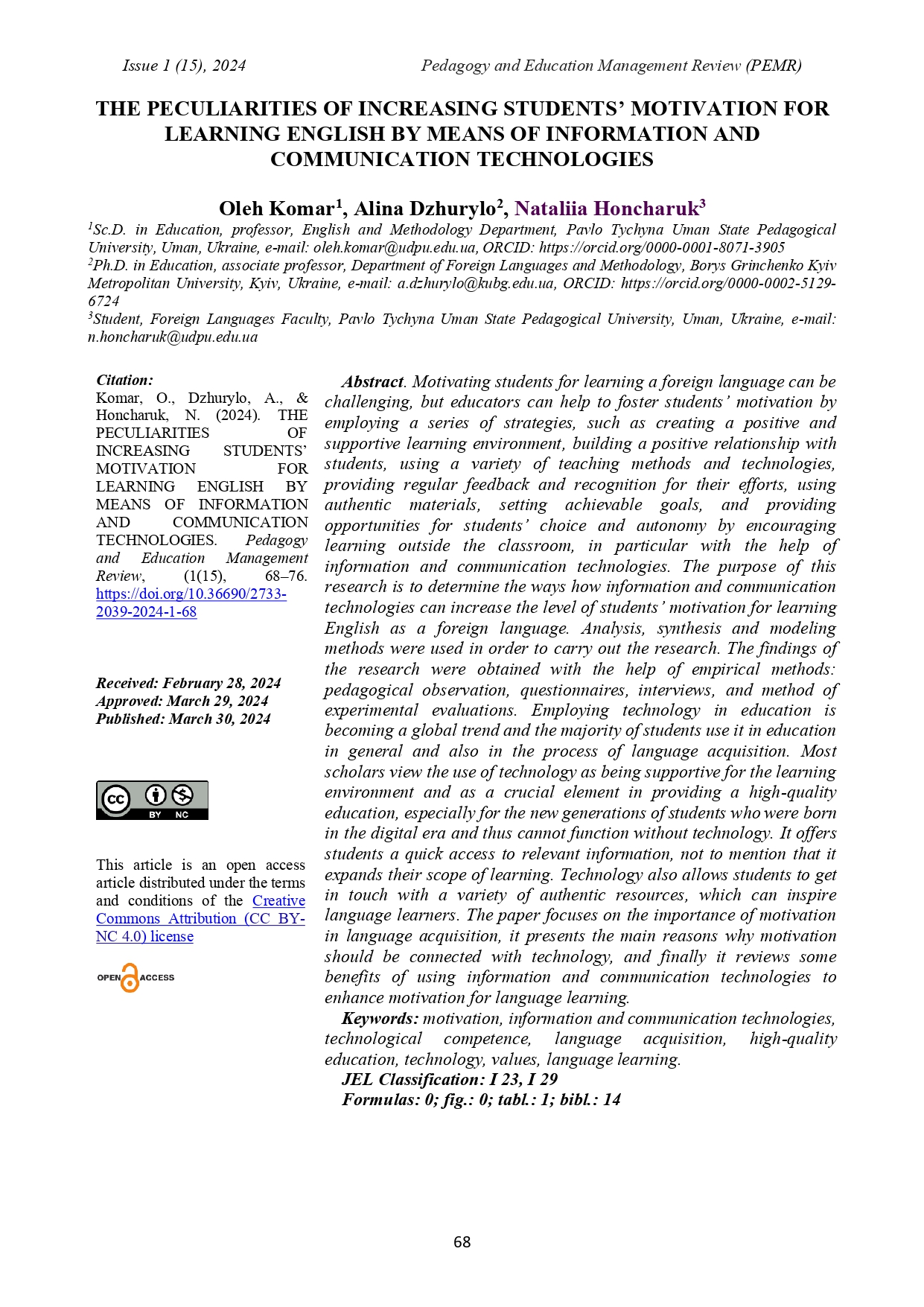THE PECULIARITIES OF INCREASING STUDENTS' MOTIVATION FOR LEARNING ENGLISH BY MEANS OF INFORMATION AND COMMUNICATION TECHNOLOGIES
DOI:
https://doi.org/10.36690/2733-2039-2024-1-68Keywords:
motivation, information and communication technologies, technological competence, language acquisition, high-quality education, technology, values, language learningAbstract
Motivating students for learning a foreign language can be challenging, but educators can help to foster students’ motivation by employing a series of strategies, such as creating a positive and supportive learning environment and building a positive relationship with the students, using a variety of teaching methods, providing regular feedback and recognition for their efforts, using authentic materials, technology, setting achievable goals, and providing opportunities for student choice and autonomy by encouraging learning outside the classroom. The purpose of our research is to determine the ways how information and communication technologies can increase the level of students’ motivation for learning English as a foreign language. Analysis, synthesis and modelling methods were used to study the state of research. The results of our research were carried out with the help of empirical methods: pedagogical observation, questionnaires, interviews, testing, the method of experimental evaluations. Employing technology in education is becoming a global trend and the majority of students use it in education in general but also in the process of language acquisition. Most scholars view the use of technology as being supportive for the learning environment and as a crucial element in providing a high-quality education, especially for the new generations of students who were born in the digital era and thus can not function without technology. Technology offers students quick access to relevant information, not to mention that it expands their universe of learning. It also allows students to get in contact with a wealth of authentic resources, which can inspire language learners. The paper begins with highlighting the importance of motivation in language acquisition, then it presents the main reasons why we should connect motivation with technology, and finally it reviews some benefits of using technology to enhance language learning.
Downloads
References
Kusmaryani, W., Musthafa, B., Purnawarman, P. (2019). The influence of mobile applications on students’ speaking skill and critical thinking in English language learning. Journal of Physics: Conference Series, 1193 012008.
Yunus, M., Hashim, H., Embi, M.A., Aqsha Lubis, M. (2010). The utilization of ICT in the teaching and learning of English: ‘Tell Me More’, Procedia – Social and Behavioral Sciences, Vol. 9, 685–691.
Cowie, B., Jones, A. (2009) Teaching and Learning in the ICT Environment. In: Saha, L.J., Dworkin, A.G. (eds) International Handbook of Research on Teachers and Teaching. Springer International Handbooks of Education, Vol. 21. Springer, Boston, MA.
Wernet S., Olliges R. & Delicath T. (2000). Post course evaluation of WebCT (Web Course Tools) classes by social work students. Research on Social Work Practice, 10(4), 487-504.
Wei Y. (2022). Toward Technology-Based Education and English as a Foreign Language Motivation: A Review of Literature. Frontiers in Psychology, 13, 870540.
Aysu S. (2020). The use of technology and its effects on language learning motivation. Journal of Language Research (JLR), 4(1), 86-100.
Paudel, P. (2021). Information and communication technology in foreign language classes in English: Roles and practices. International Journal of Technology in Education and Science (IJTES), 5 (1), 37–55.
Cakici, D. (2016). The use of ICT in teaching English as a foreign language. Participatory Educational Research (PER). Special Issue, Vol. IV, 73–77.
Hamidah, A. R., Azizah, R., Shah, R. A. W., Faizah, M. N., Wan, Z. W. Z., & Mohd, A. B. (2017). Factors affecting motivation in language learning. International Journal of Information and Education Technology, Vol. 7, 543–547.
Purmama, N.A., Rahayu, N. S., Yugafiati, R. (2019). Students’ motivation in learning English. PROJECT (Professional Journal of English Education), Vol. 2, No. 4, 539–544.
Ryan, R. M. & Deci, E. L. (2009). Promoting self-determined school engagement: Motivation, learning, and well-being. In: K. R. Wentzel & A. Wigfield (Eds.), Handbook of motivation at school. New York: Routledge. 171–196.
Kosaki, Y., Dickinson, A. (2010). Choice and contingency in the development of behavioral autonomy during instrumental conditioning. Journal of Experimental Psychology: Animal Behavior Processes, 36 (3), 334.
Spratt, M., Humphreys, G. and Chan, V. (2002). Autonomy and motivation: Which comes first? Language Teaching Research, 6(3), 245–266.
Honcharuk Vit., Honcharuk Val. (2021). Digital competence as a component of a teacher’s professional culture. Current issues of humanitarian sciences: interuniversity collection of scientific works of young scientists of the Ivan Franko Drohobych State Pedagogical University, Issue 41, Vol. 1, 202–210.







